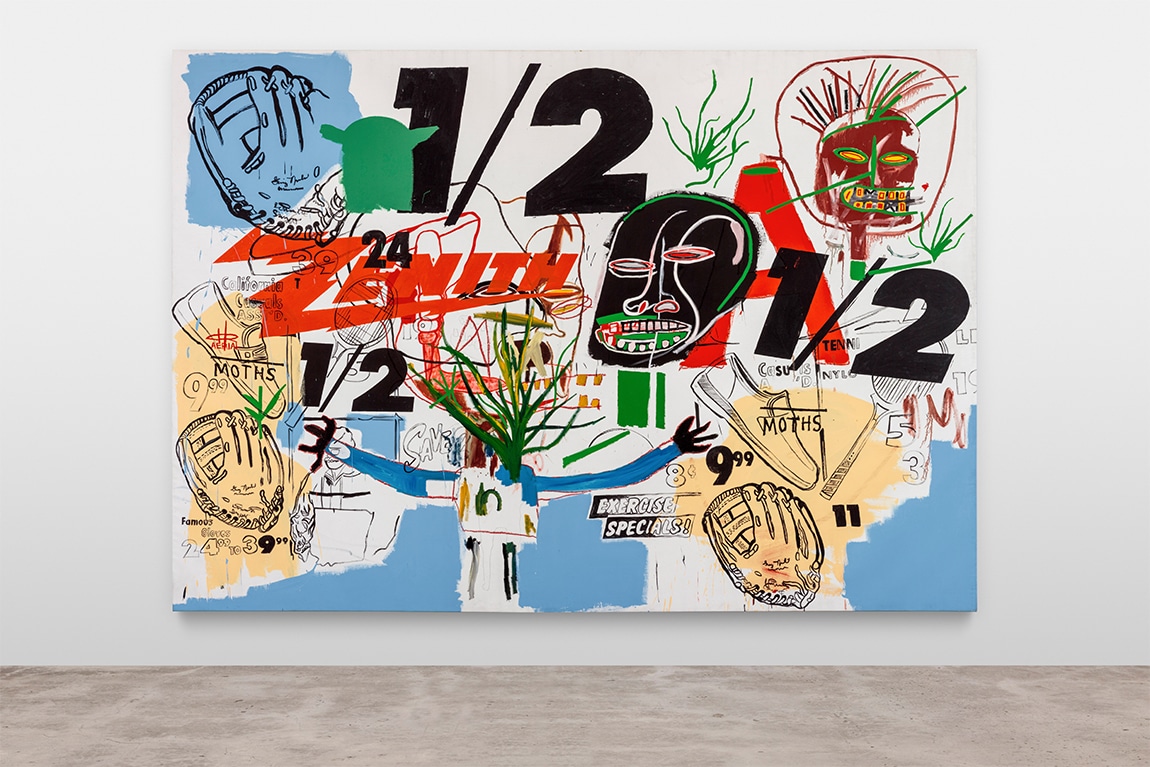
Untitled is the most significant collaboration painting to appear at auction in a decade, and follows last year’s blockbuster retrospective at Fondation Louis Vuitton in Paris and the Brant Foundation in New York.
This May, Sotheby’s will present as a highlight of the Contemporary Evening Auction one of the most significant paintings created jointly by legendary artists Andy Warhol and Jean-Michel Basquiat during their famed period of collaboration from 1983 – 1985. The painting, Untitled (1984), is a large-scale example of their multi-year creative experiment that fused their distinctive visual languages and styles–Warhol’s signature use of screenprinting and mechanically produced imagery, such as corporate logos, coupled with Basquiat’s expressionistic, figurative scrawls in paintstick–to create one of the most singular bodies of work in 20th century art. In the four decades since their creation, the Warhol-Basquiat collaboration paintings have only added to the mystique and legend of their creators, and stand out as daring testaments to their artistic partnership and friendship.
Coming to auction for the first time in nearly 15 years with an estimate upon request, Untitled’s sale will mark a major new benchmark price for the series. The sale follows a period of recent critical reappraisal and cultural attention for Warhol-Basquiat works, including a blockbuster retrospective held last year at the Fondation Louis Vuitton in Paris. Titled Basquiat x Warhol: Painting Four Hands, the exhibition represented the largest collection of collaboration paintings ever exhibited, and a version of the exhibition travelled later in 2023 to the Brant Foundation in New York. Untitled was a centerpiece of both exhibitions, and together the surveys marked the most significant ever presentation of these famed collaborative works.
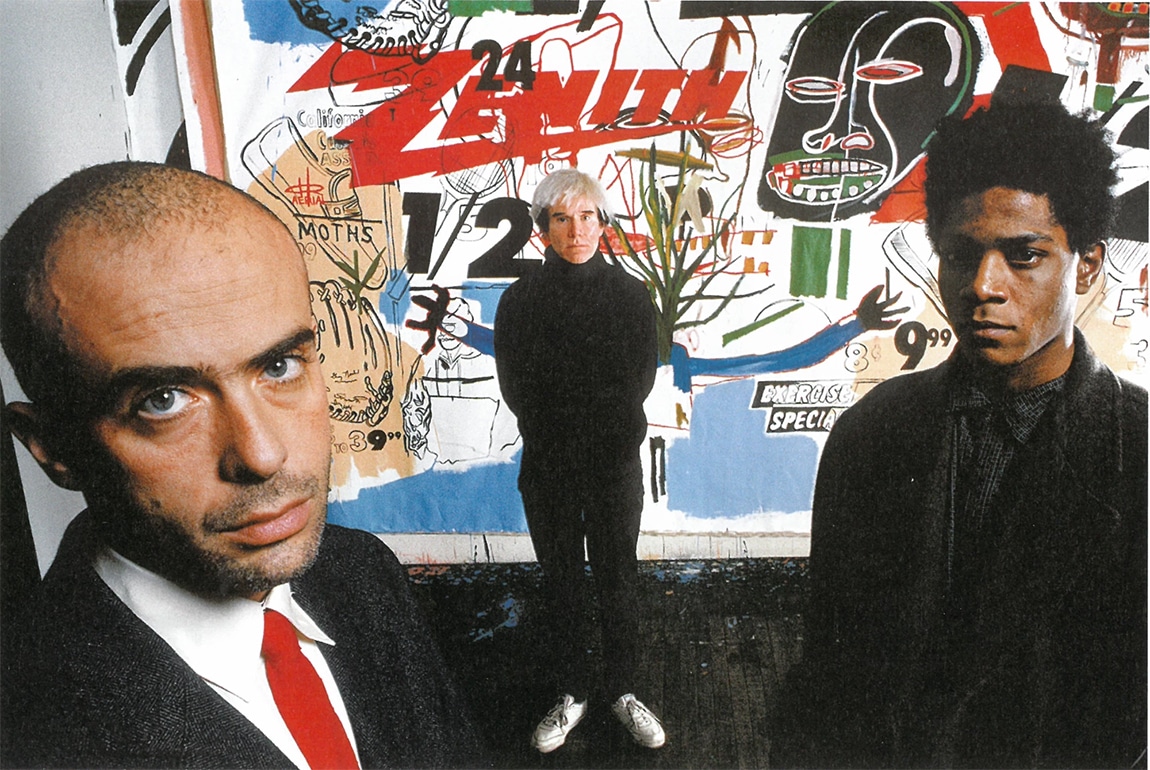
The collaborative works were also even the subject of a 2022 dramatization of their artistic endeavor titled The Collaboration, which debuted on London’s West End and The Young Vic before debuting later that year on Broadway. The play, which starred Paul Bettany as Warhol and Jeremy Pope as Basquiat, tells the story of how the two artists began their collaborative journey and is currently being adapted into a film.
Before the May auction in New York, Untitled will be on view in Hong Kong (April 2 – 6) and London (April 11 – 12) before returning to New York for Sotheby’s marquee week exhibition in early May.
The Collaboration Paintings
“When Warhol and Basquiat first revealed the fruits of their collaboration at Tony Shafrazi Gallery in 1985, the critical reception failed to see the true artistic vision of what is undoubtedly the most important artistic collaboration of the 20th century. Nearly 40 years later, the collaborative works are now, rightfully, seen as a landmark and an integral part of both artists’ bodies of work, synthesizing their contrasting styles and visions with total iconoclasm. The series showcases not only the distinctive genius of two singular artists, but also an entirely new artistic voice created in a momentary flash that would never again be replicated.”
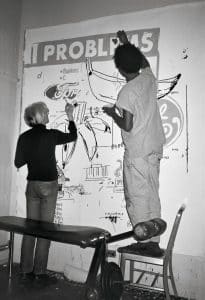
By 1983, Jean-Michel Basquiat had firmly established himself as the leader of a new generation of artists lighting up New York’s Downtown scene, winning himself the acclaim and attention not seen by an American artist since Andy Warhol rose to fame two decades earlier in the 1960s. Basquiat emerged as the young art world prodigy of the 1980s known for his gritty street art origins and his reinvigoration of painting with raw, gestural bravura. Within a few years, Basquiat was firmly established as a major new artistic voice whose reputation was quickly growing.
In contrast to Basquiat’s fast rising star, Warhol was the éminence grise of New York’s art scene. But, for all of Warhol’s influence and star power, the famed artist had also lost some of the verve that defined his career in the 1960s (his 1973 exhibition of portraits at the Whitney Museum of Art was viewed by critics as a misstep and is often cited as a turning point in how Warhol was perceived by critics and the culture at large), taking on a new role as the larger-than-life celebrity artist. Still presiding over the Factory, Warhol consistently, if not quietly, produced a significant body of work during this period, including his Oxidation series, Rorschach blots, and the Shadow paintings–all of which saw new experimentation in form and subject for the artist that would help define his later output.
It was against this backdrop that, at the suggestion of renowned, Zurich-based gallerist Bruno Bischofberger, who had formally introduced the artists a year before in 1982, Basquiat and Warhol began their fated collaboration. To produce their joint works, Warhol and Basquiat each took turns adding layers of imagery to the canvas. Their collaboration expands on the Surrealistic tradition of the “exquisite corpse,” a composition where different artists draw spontaneous images without showing them to each other, ultimately resulting in a hybrid of their work. The result was a series of approximately 160 paintings created over a two-year period.
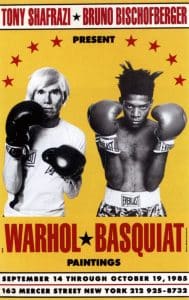
Fellow artist and friend Keith Haring witnessed first-hand the Warhol and Basquiat collaborating on these paintings, remarking on their natural harmony as artistic partners and their method: “[t]he collaborations were seemingly effortless. It was a physical conversation happening in paint instead of words,” in which the two artists merged into a “third, distinctive and unique mind.”
Ultimately, their collaboration came to an unceremonious end when their exhibition at the Tony Shafrazi Gallery in 1985 that marked the public unveiling of the works was received with mostly negative reviews from critics, some of whom took the exhibition as an opportunity to personally criticize Warhol in particular for manipulating Basquiat and trying to serve his own ends. While the reaction did not create an irreparable rift between Basquiat and Warhol, the reception of the exhibition undoubtedly caused the two artists to drift apart; they would never again collaborate before their deaths a few years later.
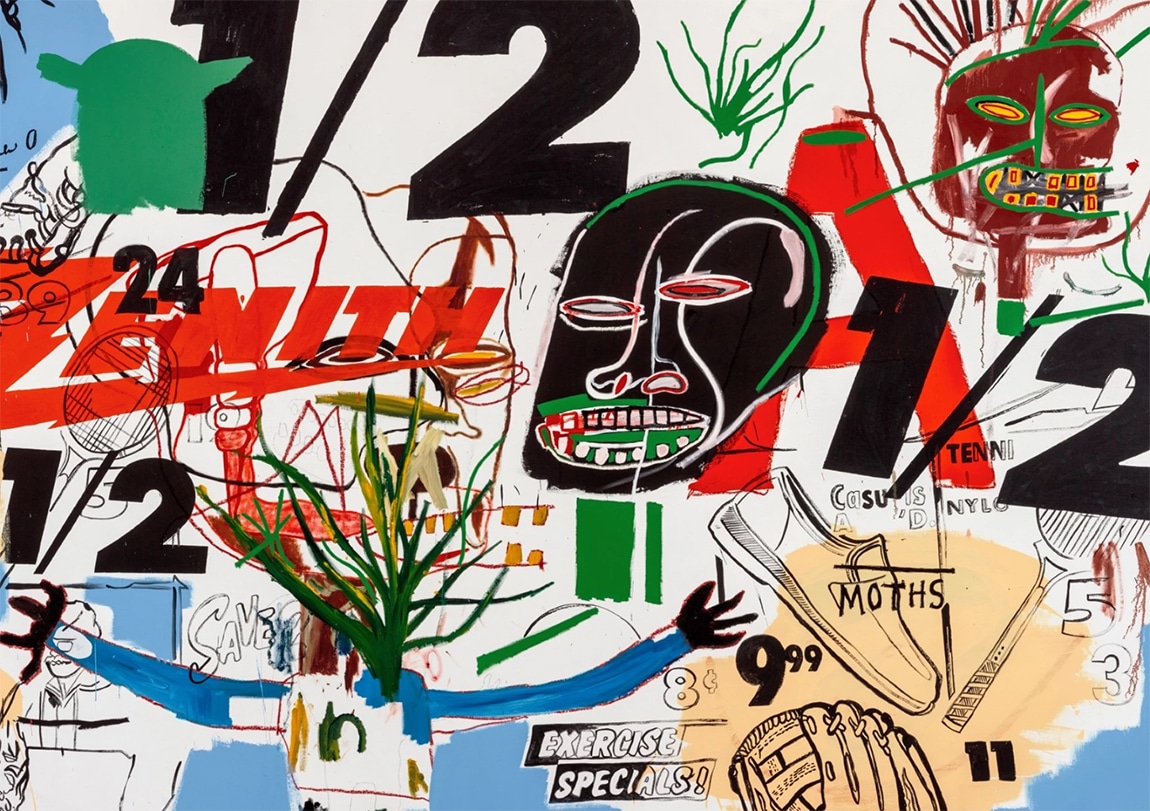
“Of all the Warhol-Basquiat works from this brief and fertile moment, Untitled stands out as one of the supreme examples, fully showcasing the range of their artistic powers. The painting is a masterpiece of juxtaposition and contradiction: the cool, mechanical restraint of Warhol’s imagery, overlaid with Basquiat’s anarchic energy and freewheeling technique. Warhol and Basquiat perform a call and response throughout the painting, riffing and improvising off one another’s work to create a radical, harmonious symphony of color, imagery and form.”
Measuring nearly 10 feet high by 13 feet wide, the monumental scale of Untitled, one of the largest from the entire collaboration series, provided ample canvas space for both artists to work side-by-side and explore their joint creative efforts without restriction. As was typical in the collaborations, Warhol was the first to lay down his imagery, which in this work consisted of baseball mitts, tennis rackets, sneakers, numbers, and the Zenith electronics logo. Once the composition was mapped out with the graphics provided by Warhol, Basquiat filled in other parts of the canvas with his signature swathes of color, jagged scrawl, and totemic heads bearing toothsome grins and spiky hair.
The power of Untitled is derived from a synthesis so complete that the resulting work could have been painted by an entirely different artist. The chaos of the composition wonderfully captures the feeling of excitement of both artists energized by this collaboration, showcasing the raw youth of Basquiat juxtaposed with the age and experience of Warhol, each finding a foil in his counterpart.
The age difference is further reinforced with the “½” reprinted throughout the canvas. At face value, the fraction can be read as the gap in age between the artists; at the time, Basquiat was 24 while Warhol was 56. A rare union of artists from different generations, Untitled evinces a creative tension in the best sense, a fully activated composition that is close in kinship with Basquiat’s desire for the viewer to delve through layers of symbolism and meaning, while also fully expressing the iconography and print style that Warhol made famous. The tension between these two styles creates an unmistakably dynamic rapport on the canvas, reflecting the symbiotic relationship that the two artists shared off the canvas.
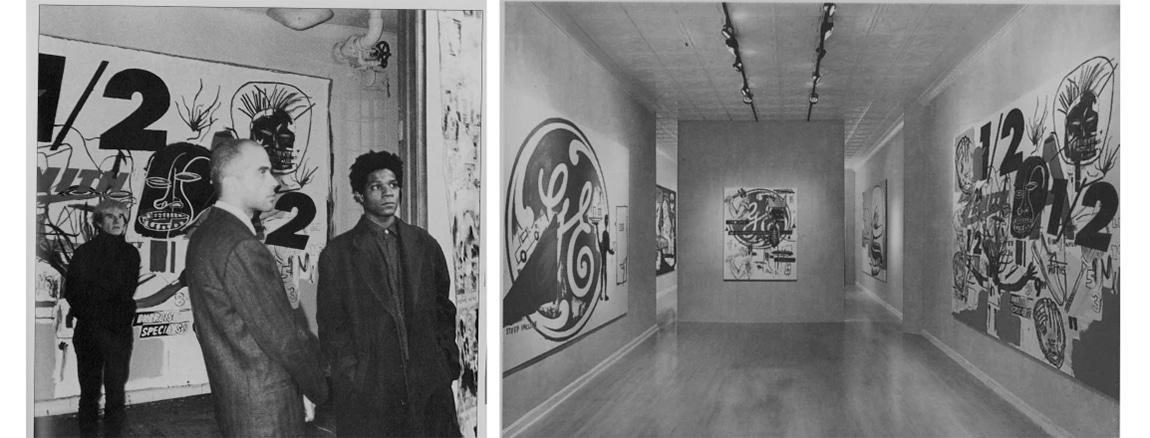
The towering scale of the painting also spotlights their larger-than-life personas at the time the work was completed. Dated to 1984, Warhol had reigned the New York avant-garde for two decades. However, when the pair were introduced just two years prior in 1982, Basquiat was a young street artist with no formal art training who had just emerged into mainstream legitimacy. An autodidact, Basquiat offered a fresh and contrarian perspective that reinvigorated Warhol–even inspiring him even to once again use the paintbrush–while the well-established Warhol plugged Basquiat into a vast network that magnified his critical and cultural ascendancy.
Each already prodigiously and radically inventive in their own right, Basquiat and Warhol’s artistic styles were strikingly different. However, there are some similarities in inspiration: both artists looked to popular culture for imagery. Warhol had long been interested in advertising, newspapers, and Hollywood stars; Basquiat to jazz musicians and professional athletes. In Untitled, the dialogue shared between the two artists powerfully manifests across the canvas, which embeds the zeitgeist of 1980s America that they respectively defined: the cult of athletic celebrity, the allure of consumer culture, the specter of urban decay.
Testifying to its significance, Untitled was a centerpiece of the seminal 1999 exhibition Collaborations held at Tony Shafrazi Gallery and was since included in Basquiat’s posthumous retrospective held at Brooklyn Museum; the Museum of Contemporary Art, Los Angeles; and The Museum of Fine Arts, Houston in 2005-2006. Most recently, Untitled was included in the critically acclaimed exhibition dedicated to the series, Basquiat x Warhol held at the Fondation Louis Vuitton, Paris in 2023, which subsequently travelled to the Brant Foundation in New York.
Before the May auction in New York, Untitled will be on view in Hong Kong (April 2 – 6) and London (April 11 – 12) before returning to New York for Sotheby’s marquee week exhibition in early May.
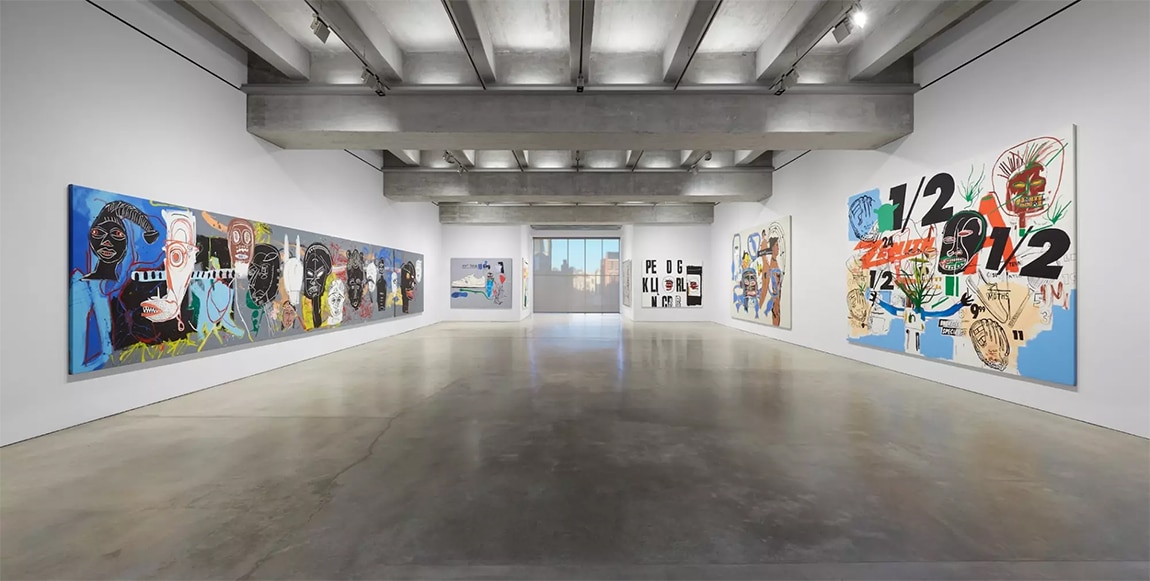
POSTED WITH PERMISSION. COPYRIGHT SOTHEBY’S. Click to read original article.

